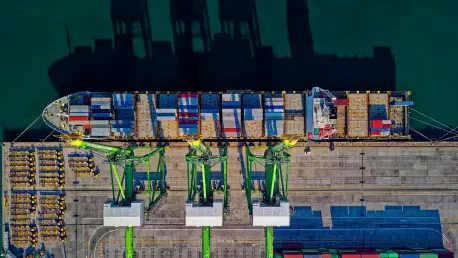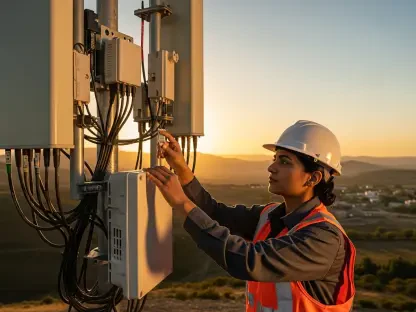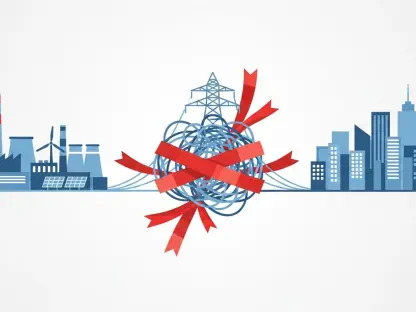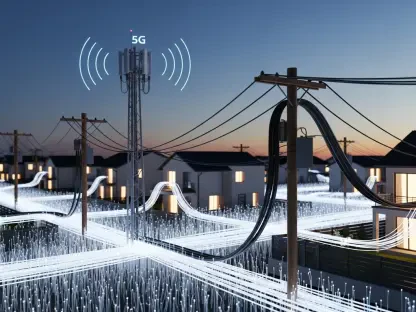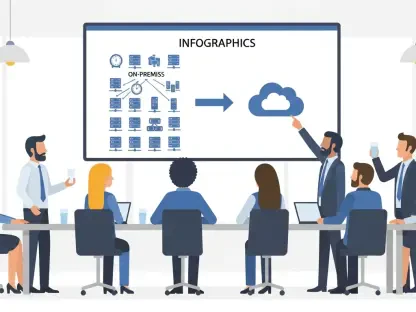What if the backbone of global trade could operate with the precision of a Swiss watch, moving goods faster and safer than ever before, while transforming bustling ports into hubs of efficiency? Picture a port where massive containers are unloaded every few seconds, not by hundreds of workers, but by a handful of operators overseeing robotic systems. This is no longer a distant vision but a reality being shaped by Ericsson through the power of 5G technology. As ports struggle to keep pace with soaring trade volumes, this telecommunications leader is stepping in to transform these vital hubs into models of efficiency.
The significance of this shift cannot be overstated. Ports handle over 80% of global trade by volume, yet many still grapple with outdated processes that cause delays and inflate costs. Ericsson’s pioneering work with 5G networks offers a solution, slashing human intervention while boosting throughput. This story matters because it touches every supply chain, influencing how quickly and reliably goods reach markets worldwide. The following sections delve into how this technology is reshaping port operations and what it means for industries everywhere.
Why 5G Matters in Modern Ports
Ports are under relentless pressure to manage increasing cargo loads with speed and accuracy. Traditional methods often fall short, leading to bottlenecks that ripple across global logistics. The introduction of 5G technology, with its promise of ultra-fast, low-latency communication, stands as a game-changer. Ericsson’s focus on this innovation is helping ports evolve into highly automated environments where delays become a relic of the past.
This transformation is critical as trade demands continue to escalate. A report from the United Nations Conference on Trade and Development highlights that maritime trade volumes are projected to grow significantly over the next decade. With 5G, ports can handle such growth by automating tasks like container handling, reducing turnaround times, and minimizing errors. Ericsson’s role in deploying these networks positions it as a key player in addressing these pressing challenges.
Moreover, the environmental impact cannot be ignored. Automated systems powered by 5G often consume less energy per operation compared to manual processes, supporting sustainability goals. By cutting idle times for ships and optimizing resource use, ports can lower their carbon footprint. This dual benefit of efficiency and eco-friendliness underscores why 5G adoption in ports is a priority worth watching.
The Broader Impact of 5G on Port Automation
Beyond immediate operational gains, the integration of 5G into port systems signals a profound shift in industrial strategy. Many ports still depend on labor-intensive setups prone to human error and inefficiency. Ericsson’s deployment of standalone 5G networks—known for their high reliability and near-instantaneous data transfer—enables real-time control of machinery, paving the way for seamless automation.
This technological leap addresses deeper economic concerns. Rising labor costs and the urgent need for faster cargo processing are pushing port authorities to seek innovative solutions. Private 5G networks, tailored to specific industrial needs, ensure secure and uninterrupted connectivity, allowing for precise coordination of automated equipment. This is not merely about upgrading infrastructure but about redefining how global trade operates in a hyper-connected era.
The implications extend to safety as well. Automated systems, guided by 5G’s low-latency capabilities, reduce the risk of accidents by limiting human exposure to hazardous tasks. From robotic cranes to self-navigating vehicles, the technology minimizes workplace dangers while maintaining high productivity. This safety aspect adds another layer of urgency to adopting such advancements across port facilities worldwide.
Ericsson’s Trailblazing Efforts in Port Automation
Ericsson’s contributions come alive through transformative projects that set benchmarks in the industry. At Rotterdam World Gateway in the Netherlands, a staggering level of automation has been achieved: just 15 staff oversee 84 automated guided vehicles (AGVs), unloading a container every 12 seconds. Enabled by 5G’s rapid data transmission, this port exemplifies how connectivity can slash human involvement while maximizing output.
Elsewhere, Ericsson’s collaboration with Singtel at Singapore’s Tuas Mega Port showcases adaptability to complex needs. This hybrid public-private network utilizes multiple spectrum bands to ensure robust performance and incorporates network slicing for prioritized data flow. Such tailored solutions meet stringent security and operational demands, proving that 5G can be customized for diverse port environments with remarkable results.
Additional projects, like those at the Port of Tyne in the UK and the Port of Belfast in Northern Ireland, further demonstrate Ericsson’s global reach. Each initiative adapts to local conditions, whether it’s enhancing cargo tracking or streamlining logistics with automated systems. These case studies collectively highlight a consistent ability to elevate port operations, setting a new standard for speed and precision in the sector.
Expert Perspectives on Ericsson’s 5G Innovations
Insights from industry leaders shed light on the profound impact of these advancements. Peter Linder, Head of Thought Leadership at Ericsson, has noted that ports like Rotterdam reveal “how digital maturity can dramatically reduce human intervention while amplifying productivity.” His observation points to a future where technology drives operational excellence with minimal oversight.
Adding a technical dimension, Asad Khan from SNS Telecom & IT elaborates on the infrastructure at Tuas Mega Port, describing it as a “sophisticated network leveraging multiple spectrum bands and virtual private setups for secure, industrial-grade connectivity.” This expert analysis underscores the engineering prowess behind these deployments, showing that success hinges on customized, resilient systems.
Together, these viewpoints illustrate a comprehensive approach. While practical outcomes like increased throughput are evident, the underlying technology—designed with precision and security in mind—ensures long-term reliability. This blend of vision and execution positions Ericsson’s solutions as a blueprint for industrial transformation on a global scale.
Steps for Ports to Embrace Ericsson’s 5G Model
For port operators aiming to replicate such success, a structured path emerges from Ericsson’s initiatives. The first step involves a thorough assessment of operational needs and security priorities to define the scope of a private 5G network. Understanding specific challenges, such as high traffic zones or data sensitivity, lays the foundation for effective implementation.
Collaboration with telecom specialists comes next, focusing on designing a bespoke solution. Features like network slicing, which prioritizes critical data streams, or multi-band spectrum usage for broader coverage, can be integrated to enhance performance. This tailored approach ensures that the network aligns with the unique demands of each facility, optimizing automation capabilities.
Finally, integrating automated technologies—such as AGVs or robotic cranes—requires leveraging 5G’s low-latency connections for real-time control. This step completes the transition toward digital maturity, cutting labor expenses and boosting efficiency. Ports adopting this framework can mirror the remarkable outcomes seen in Ericsson’s projects, positioning themselves as leaders in modern trade logistics.
Reflecting on a Transformative Journey
Looking back, Ericsson’s journey in port automation stands as a testament to the power of 5G technology in reshaping industrial landscapes. Projects spanning Rotterdam to Singapore demonstrate that private networks can drive unprecedented efficiency, slashing operational delays and enhancing safety. Each initiative, tailored to its environment, marks a step forward in addressing the complexities of global trade.
The path ahead calls for broader adoption across ports and industries. Stakeholders are encouraged to invest in assessing their connectivity needs and partnering with experts to deploy scalable 5G solutions. Such efforts promise to not only streamline operations but also build resilience against future trade demands.
Ultimately, the legacy of these advancements points toward a collaborative future. By sharing best practices and scaling successful models, the industry can collectively elevate standards of efficiency and sustainability. This vision of interconnected, automated ports offers a powerful blueprint for navigating the evolving challenges of global commerce.
